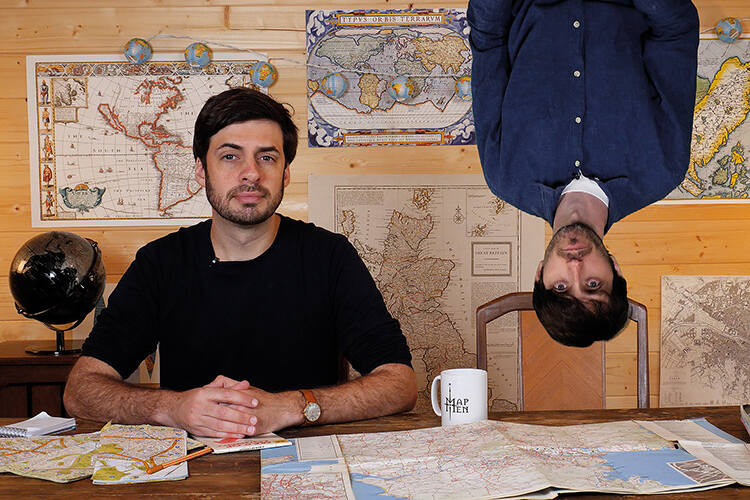
The founders and stars of the phenomenally popular YouTube series Map Men discuss their unique blend of comedy and cartography
By
For Jay Foreman and Mark Cooper-Jones, now better known as the Map Men, it all began with a few meetings at the Edinburgh Festival Fringe, where Jay was busy entertaining the crowd with a musical-comedy act and Mark was doing stand-up about the trials and tribulations of teaching geography while fending off the inevitable heckling about colouring-in. Realising they shared two loves – comedy and geography – they decided to collaborate and in 2016, the Map Men YouTube channel was born, along with its catchphrase: ‘We’re the men and here’s the map.’
With their characteristic straight-faced delivery and fast-paced jokes, the duo use each comedy short to answer questions such as ‘Where is the UK’s north–south divide?’ (time to consult the University of Oxford’s Danny Dorling), ‘What will the world look like in 250 million years?’ (a ‘continental group hug’ called Novapangaea – maybe) and ‘Who owns the South China Sea?’ (a sticky sea situation), and to tackle topics including the world’s silliest time zones and the world’s oldest border. While some focus on the sorts of questions you might argue about at a dinner party (What makes a city a city?), others take on more niche map-related phenomena. With each video receiving somewhere in the order of a million views, the formula clearly works.
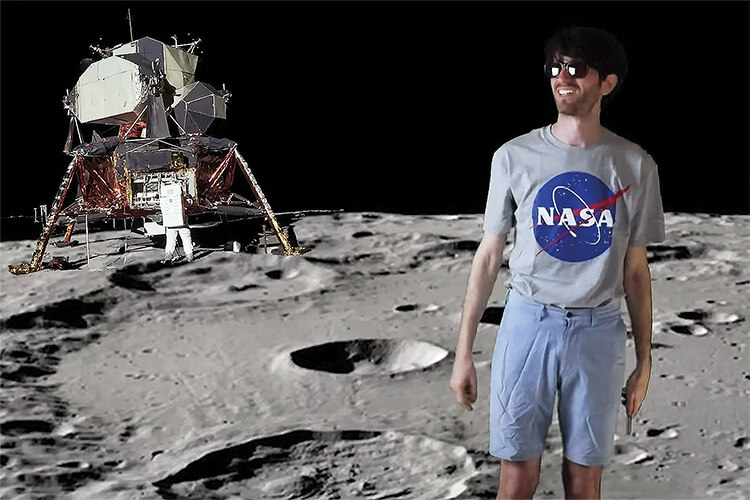
‘I like to think it might just be the simplicity of the title Map Men. The reason I like to think that is because I came up with it,’ says Mark, who moved from geography teacher to stand-up comic and now works as a documentary producer. ‘It also seems to me like maps have been having a nice renaissance for the past ten or 20 years. They’re such great windows onto history and such great aesthetic artefacts.’
‘As little as ten years ago, maps were something that you just had to live with and everybody had an A-to-Z in the car,’ says Jay, who is the main comedic influence behind the channel, having already found success with a series on London’s architecture called Unfinished London. ‘But now that everyone has a sat nav, I think maps have become, for want of a better word, more geeky. You get people who didn’t realise that they were interested in maps or geography until they see an episode of Map Men and they’ll say: “Oh, yeah, maps are my guilty pleasure.” And I don’t think people would have necessarily talked like that about maps ten years ago, because they used to be something that we depended on. And now they have become something that we enjoy.’
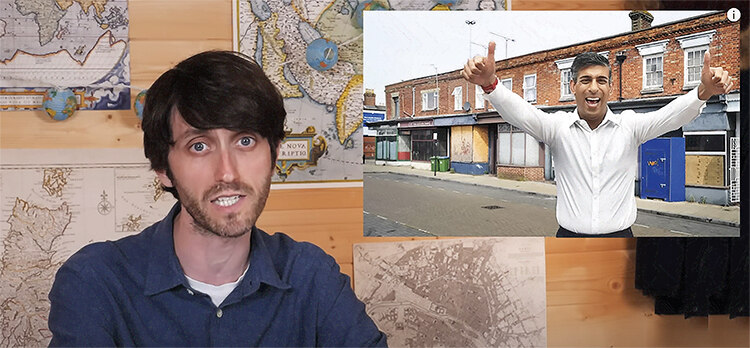
Bringing each map to life and producing each video is a time-consuming affair. With both Monty Python and the strange old educational videos they remember from childhood as influences, the videos always feature Jay and Mark behind their Map Men desk, but also include live-action sketches, graphics and a smattering of silly props and sound effects. A huge amount of effort is put into tiny elements of each video. Jay remembers hiring a drum kit, disassembling it, reassembling it and learning to use it for a single second of footage – all to top off one (intentionally) bad pun. ‘It kind of feels like that’s a waste of our time,’ he says. ‘But on the other hand, these are the reasons that people say they like our channels. So we’re sort of duty bound to keep doing this sort of thing and to put that kind of effort in.’
Mark agrees, crediting Jay’s comedy style for pulling in the audience. ‘I think people have appreciated that level of effort. The idea is that we do it without self-congratulation; we don’t linger on those things. We do the jokes with a straight face. In the comedy world, it’s what we call throwing them under the bus. I think we’ve managed to somehow stumble upon a nice, winning combination of a topic that people are really into at the moment and want to know more about, with a way of doing it that is all credit to Jay.’
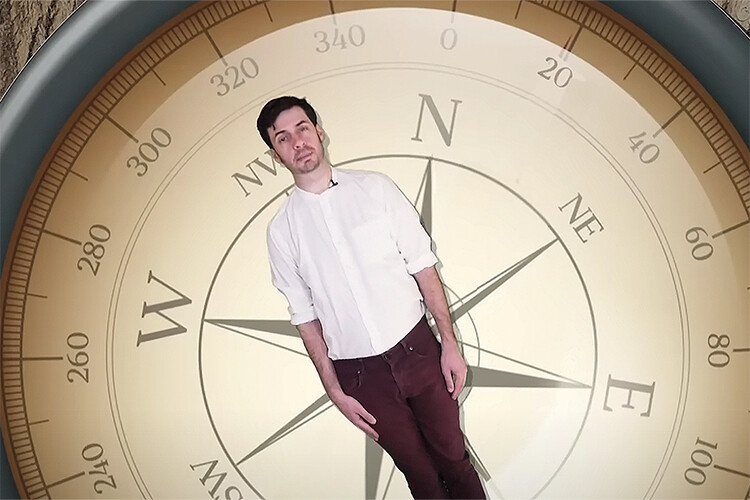
There’s also geographical accuracy to be aware of. ‘One of the things that Mark and I are quite proud of is that we’re able to combine true facts, true geography, and use the humour not to distract from the facts but to help the facts be more memorable,’ says Jay. He admits that in the early days, with only a handful of viewers, accuracy wasn’t so important, but these days, if they make a mistake they’re sure to hear about it. ‘Now the videos usually get more than a million views, which is very exciting, but it also means that if we make any kind of mistake, whether it’s a tiny spelling mistake or a great big howler, we will know about it right away. The best way to do research for a topic is to release a video about it on YouTube and then watch all the corrections come flooding in the comments.’
As an ex-geographer and geography teacher Mark was always keen to convey the real importance of maps through the series. Whether they’re covering the numerous enclaves on the border between India and Bangladesh (one of which, the world’s only third-order enclave, they liken to a ‘Tic Tac inside a Polo inside a bagel inside Bangladesh’) or the vastly complex web of cables that connects the world’s computers, they have no qualms about tackling serious geographic topics through the comedy lens.
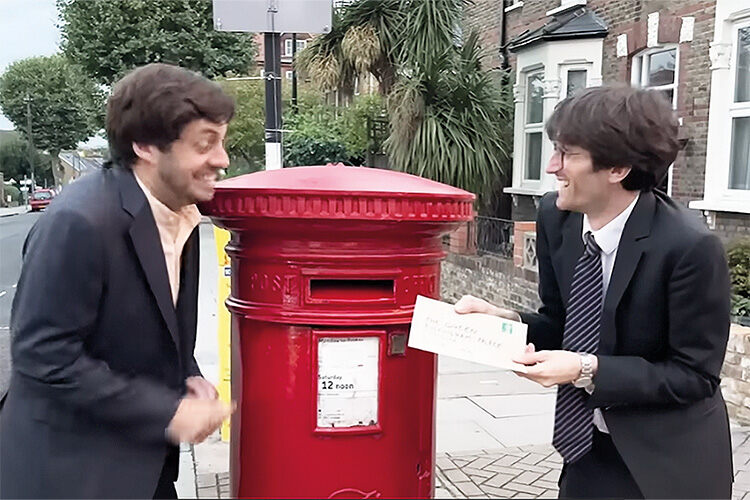
‘Sometimes our topics are to do with taking a question that we’re interested in – and there’s a map that you can usually apply to that question. But in the beginning, it was actually about maps and power and how they work themselves, and how they give you a view of the world. It was about making people question that in a way that geographers are always taught to. Anyone who studied geography at A-level, or certainly at university level, will have come across the idea that maps shaped the world and are not just reflections of it.’




